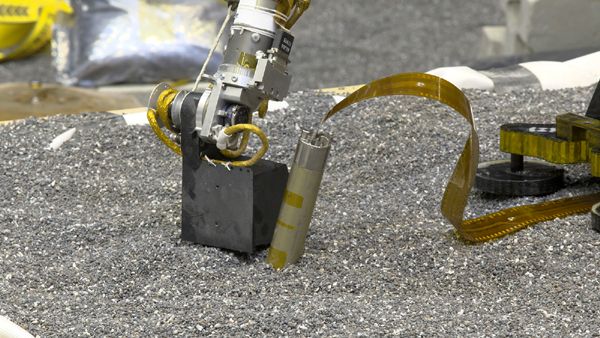
NASA / JPL - Caltech
InSight's Team Tries New Strategy to Help the 'Mole' (News Release)
Scientists and engineers have a new plan for getting NASA InSight's heat probe, also known as the "mole," digging again on Mars. Part of an instrument called the Heat Flow and Physical Properties Package (HP3), the mole is a self-hammering spike designed to dig as much as 16 feet (5 meters) below the surface and record temperature.
But the mole hasn't been able to dig deeper than about 12 inches (30 centimeters) below the Martian surface since Feb. 28, 2019. The device's support structure blocks the lander's cameras from viewing the mole, so the team plans to use InSight's robotic arm to lift the structure out of the way. Depending on what they see, the team might use InSight's robotic arm to help the mole further later this summer.
HP3 is one of InSight's several experiments, all of which are designed to give scientists their first look at the deep interior of the Red Planet. InSight also includes a seismometer that recently recorded its first marsquake on April 6, 2019, followed by its largest seismic signal to date at 7:23 p.m. PDT (10:23 EDT) on May 22, 2019 — what is believed to be a marsquake of magnitude 3.0.
For the last several months, testing and analysis have been conducted at NASA's Jet Propulsion Laboratory in Pasadena, California, which leads the InSight mission, and the German Aerospace Center (DLR), which provided HP3, to understand what is preventing the mole from digging. Team members now believe the most likely cause is an unexpected lack of friction in the soil around InSight — something very different from soil seen on other parts of Mars. The mole is designed so that loose soil flows around it, adding friction that works against its recoil, allowing it to dig. Without enough friction, it will bounce in place.
"Engineers at JPL and DLR have been working hard to assess the problem," said Lori Glaze, director of NASA's Planetary Science Division. "Moving the support structure will help them gather more information and try at least one possible solution."
The lifting sequence will begin in late June, with the arm grasping the support structure (InSight conducted some test movements recently). Over the course of a week, the arm will lift the structure in three steps, taking images and returning them so that engineers can make sure the mole isn't being pulled out of the ground while the structure is moved. If removed from the soil, the mole can't go back in.
The procedure is not without risk. However, mission managers have determined that these next steps are necessary to get the instrument working again.
"Moving the support structure will give the team a better idea of what's happening. But it could also let us test a possible solution," said HP3 Principal Investigator Tilman Spohn of DLR. "We plan to use InSight's robotic arm to press on the ground. Our calculations have shown this should add friction to the soil near the mole."
A Q & A with team members about the mole and the effort to save it is at: https://mars.nasa.gov/news/8444/common-questions-about-insights-mole/?site=insight
JPL manages InSight for NASA's Science Mission Directorate. InSight is part of NASA's Discovery Program, managed by the agency's Marshall Space Flight Center in Huntsville, Alabama. Lockheed Martin Space in Denver built the InSight spacecraft, including its cruise stage and lander, and supports spacecraft operations for the mission.
A number of European partners, including France's Centre National d'Études Spatiales (CNES) and the German Aerospace Center (DLR), are supporting the InSight mission. CNES provided the Seismic Experiment for Interior Structure (SEIS) instrument to NASA, with the principal investigator at IPGP (Institut de Physique du Globe de Paris). Significant contributions for SEIS came from IPGP; the Max Planck Institute for Solar System Research (MPS) in Germany; the Swiss Federal Institute of Technology (ETH Zurich) in Switzerland; Imperial College London and Oxford University in the United Kingdom; and JPL. DLR provided the Heat Flow and Physical Properties Package (HP3) instrument, with significant contributions from the Space Research Center (CBK) of the Polish Academy of Sciences and Astronika in Poland. Spain's Centro de Astrobiología (CAB) supplied the temperature and wind sensors.
Source: Jet Propulsion Laboratory

No comments:
Post a Comment